Subjects:
- General
- Operation of the transistor
- The transistor as a switch
- The transistor as an amplifier
- Transistor characteristic
- Example circuit with a characteristic
- Darlington transistor
General:
Transistors have 2 different applications, they are used as:
- Amplifier (think of an audio amplifier)
- Switch (a transistor can switch large powers very quickly and is used in, among other things, control devices in the car).
Transistors are powered by current. In microprocessors, for example, one wants to keep the current intensity as low as possible in connection with heat development. The MOSFET is often used in this.
There are 2 types of transistors, namely the NPN and the PNP transistor. These are described below.
NPN Transistor:
The B stands for “Base”, the C for “Collector” and the E for “Emitter”.
With the NPN transistor, the arrow points away from the transistor. This transistor is often used when it is a 'ground circuit', where the Emitter is connected to ground.
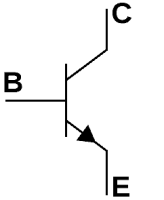
PNP transistor:
In the case of the PNP transistor, the arrow points to the transistor. A handy mnemonic for PNP is therefore “Arrow To Plate”.
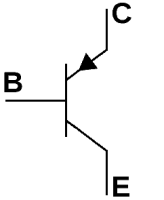
Operation of the transistor:
In automotive technology, the transistor is most commonly used as a switch, so we'll go into that now. Let's take an NPN transistor as an example.
The image shows the base on the left, above the collector and below the Emitter. When a basic current starts flowing (blue arrow), it follows its way to the Emitter. This also causes a collector current to flow to the Emitter. As soon as the base current disappears, the current from collector to Emitter also stops.
If half a base current starts to flow, half the current (compared to I max.) also starts to flow. So it can be clearly seen that the current that is switched by the transistor (from C to E) is completely dependent on the height of B.
A transistor always has voltage losses due to the PN transition. Between the Base and Emitter it is 0,7 Volt and between the Collector and Emitter 0,3 Volt.
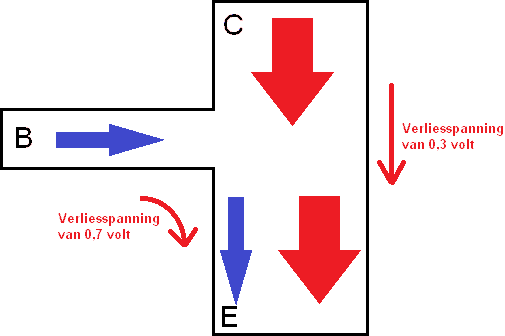
The transistor as a switch:
In the following example, a 12 volt / 5 watt lamp is controlled with a transistor. The voltage of UB1 (voltage source 1) is the battery voltage of 12 volts. The lamp is grounded. The base of the transistor is controlled with UB2; “the voltage source 2” of 6 volts.
The loss voltage between Collector – Emitter (UCE) is 0,3 volts, and between Base – Emitter (UBE) 0,7 volts. We will see this reflected in the calculation below. The amplification factor is set at 200. This can always vary. The gain factor is the ratio between the base current and the Collector-Emitter current.
A circuit must always be executed with a certain resistance (in the above diagram RB). If this resistor were not present, the transistor would immediately fail. The value that the resistor RB should have depends on all factors; namely voltages on both UB1 and UB2 and the required current for the components (resistors or lamps), etc. We will now calculate the load resistance RB.
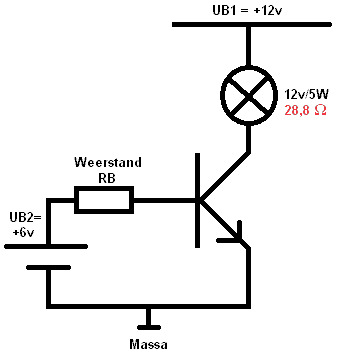
To calculate the load resistance RB, first the resistance through the lamp must be calculated.

Now that the resistance RL is known, the collector current (IC) can be calculated.
UCEsat stands for “saturation”, or in other words; saturation. As soon as the transistor is conducting, there is a voltage drop of 0,3 volts between points C and E (Collector – Emitter).
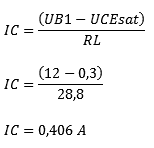
The next step is to determine the base current (IB):
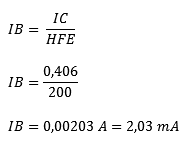
A safety margin (IBK) of 1,5 x IB applies to each transistor circuit. So the value of IB has to be multiplied by 1,5 again. The reason for this will be explained later.
The base current is only 12% of the Collector-Emitter current. It is now clearly visible that a transistor can be turned into a large main current from a small bass current.

Now that all currents in the diagram are known, the resistance RB can be calculated.
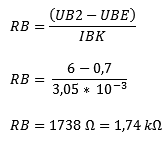
UBE is the voltage between the Base and the Emitter. Due to the conductive material in the transistor, there is always a voltage drop of 0,7 Volt between points B and E.
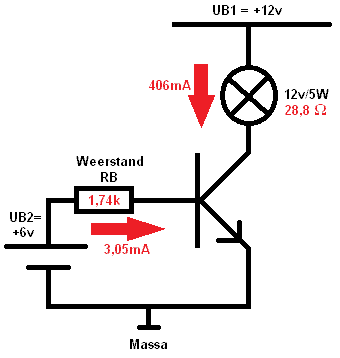
There are no standard resistors which are exactly 1,74k (Kilo-Ohm). A standard resistor with a different value must therefore be chosen. The choice must be made from the available resistors from the E12 series.

The required resistance of 1,74k is between 1,5k and 1,8k. In that case, the lower resistance value should be chosen; for 1,5k. This is so that aging and wear of the components do not affect the currents in the circuit.
The transistor as an amplifier:
The transistor can be used as an amplifier. The base current can be changed by turning a potentiometer. By varying the base current, the gain voltage, and thus the voltage across the collector-emitter, changes.
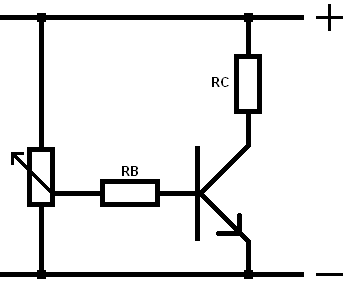
Transistor Characteristic:
A characteristic can be made of an NPN transistor, see the image below:
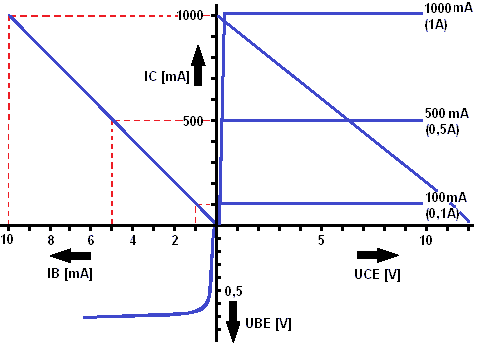
1st quadrant (top right) = UCE – IC
Up to 0,3 volts the line slopes upwards. This area is UCEsat (saturation of the transistor). After that, the line runs almost horizontally.
2st quadrant (top left) = IB – IC
Here the relationship between UB and IC is indicated. IC = HFE x IB, with in this characteristic HFE = 10, so IC is 10 times as large as IB. The safety factor of IB = 1,5 x IBK has not yet been taken into account.
3st quadrant (bottom left) = UBE – IB
The drop voltage between the base and emitter of a transistor is the threshold voltage of a diode. The threshold voltage is 0,7 Volt. From this voltage the transistor starts conducting and the base current IB starts to flow. This can also be traced back to the characteristic.
Example circuit with a characteristic:
Now it's time for a (simple) example circuit with an associated transistor characteristic. The IB = 1,5 x IBK is included here, resulting in a horizontal line on the axis of IB. In the circuit below, UB1 is the battery voltage and UBE (Base-Emitter voltage) comes from a switch or signal in a control device. To calculate the current on UBE, the current IC (collector current) must first be calculated;
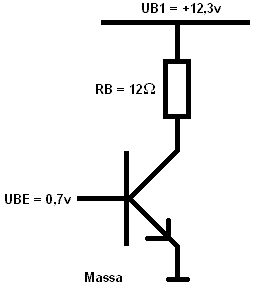
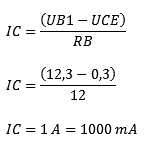
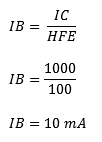

Now we know that a current of 15mA must flow through the base of the transistor to make the transistor (with the mentioned UB1 and RB) conduct completely, including the safety factor. Then the characteristic can be filled in:
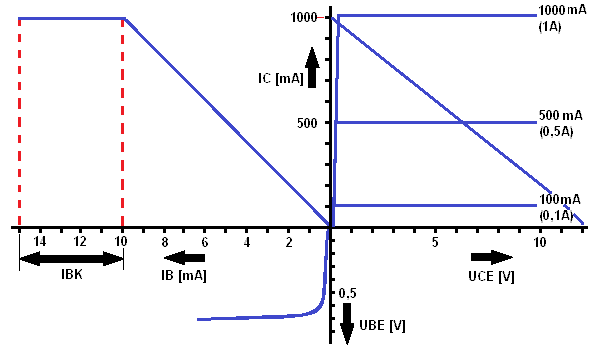
In this characteristic it can be seen that the IB (current at the base) increases to 10mA. This part, from 0 to 10 mA, is calculated with the formula: IB = IC : HFE. Then the line runs completely horizontal from 10 to 15mA. This part is the gain of 1,5 (from the calculation of IB = 1,5 x IBK). At a base current of 15mA, a collector current (IC) of 1000mA flows.
Transistors are powered by current. In microprocessors, for example, one wants to keep the current intensity as low as possible in connection with heat development. It often contains the MOSFET applied.
Darlington Transistor:
A control device sends a base current to the transistor. A transistor can be turned on by a control device with a current of 0,1 to 0,5 mA. When we want to control an actuator where a high current is required, the ECU cannot supply the necessary current for the transistor. The primary current of an ignition coil is approximately 8 amps. The control current will have to be amplified to make the transistor conduct. This presents a problem: the microprocessor cannot supply the desired current for the transistor.
By means of a Darlington transistor, a large current can be switched to the actuator with a small control current from the ECU.
The Darlington transistor consists of two transistors connected together in one package.
The collector-emitter current of T1 provides the base current of T2. This results in a large gain factor, because the gain factors of both transistors can be multiplied together.
A very small base current of T1 (only one tenth of a milliampere) is often sufficient to make T2 conductive.
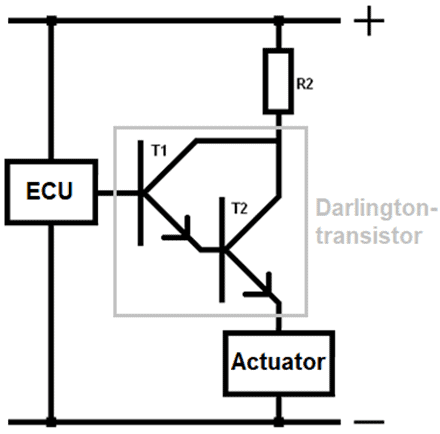
The current amplification factor (Hfed) of the Darlington transistor is usually between 1000 and 10.000. The formula to calculate the gain factor of a Darlington transistor is:
Hfed = Hfe1 * Hfe2
- Advantage: thanks to the large current amplification factor (Hfed), a small control current is sufficient to make the Darlington transistor conduct;
- Disadvantage: The base-emitter voltage of the Darlington circuit is twice that of a single transistor. Thus, the voltage drop of the Darlington transistor is significantly greater than that of a single transistor.
In the section “Output signals” on the page Interface circuits examples and applications of the Darlington transistor are listed.
Related page:
